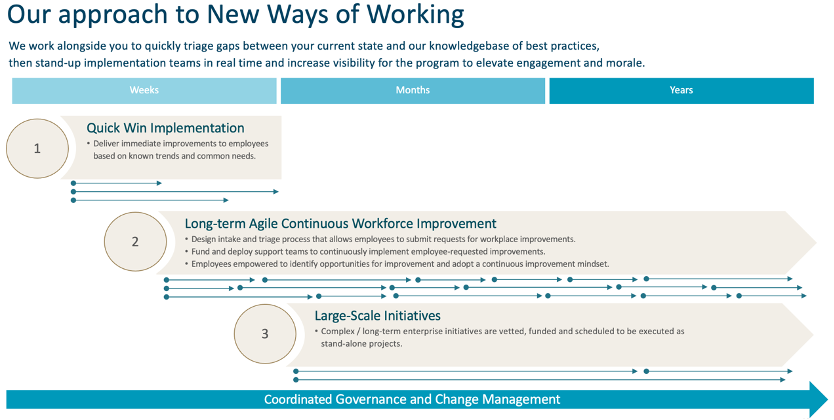Clinical Caregiver Experience: The need for immediate impact
To begin, focus on investments that create incremental wins and build momentum to reinforce your commitment to clinicians’ practice of care delivery. If your healthcare organization is serious about retaining and attracting clinicians in the long term, now is the time to take actions to align and improve processes that will empower them and bring back the joy of practicing medicine in a post-pandemic environment.
Create space for your clinical caregivers to focus on critical work
Consider this step the intake process for identifying new, and resurfacing old, ideas. A ‘return to normal’ is not the goal. Begin by having an inclusive provider discussion of expectations for the next normal and incorporate learnings from the last 12 months.
Leadership should approach every conversation with caregivers as an opportunity for requirements gathering and should consider how the day-to-day “noise” is preventing staff from attending to crucial aspects of their patient care. Reimagine how extraneous work can be

managed differently in the future. Engage your organizational improvement and effectiveness team to own this intake process, with a commitment to reducing administrative burden through human-center design principles.
Pair this work with proactive internal communication processes to confirm what you are hearing and share how this information is going to be used. This open discussion and requirements gathering should be a continuous process improvement that is part of your overall strategic plan.
Prioritize pre-pandemic initiatives that reduce clinical burnout
Engage clinicians to confirm priorities, validate and increase alignment, and establish buy-in and trust in the process. If strategic initiatives are prioritized by the same old Return on Investment (ROI) metrics, the same old projects will be prioritized. To get funding and resources to execute, it is critical to move these projects to the top of your organizational priorities.
For funding, committed organizations establish a strategic budget allocation for workforce experience and then apply prioritization criteria to disburse funds. For an efficient prioritization exercise, engage front line staff and business owners to estimate level of effort versus workforce experience impact for each initiative.
Taking a people-centered approach in prioritizing, define ROI metrics aligned to the quadruple aim to activate meaningful metrics scored in your portfolio review. Instead of relegating patient experience and provider experience as afterthoughts of program implementation, elevate these metrics as qualifiers for portfolio review to deliver a powerful message to your clinicians about your commitment to their well-being. Simple inclusions of workforce experience impact measures from above and/or clinician experience surveys can augment and elevate the priority of these important initiatives. To give caregivers hope that the future will be different, start tackling initiatives now.
Be nimble by introducing a continuous improvement model.
Healthcare systems tend to be stuck in the outdated “big project” mentality. They reconfigure whole spaces, are held back by too many legacy systems that keep them from moving to more efficient and effective tools, and generally tend to embark on projects that are time-consuming and expensive. The irony is that provider teams have a long and well-accepted history and culture of continuous improvement in clinical care delivery. Apply this same philosophy when implementing the roles, workflows, and technology that enhance workforce experience.
Adoption will also take collaboration. Take lessons from the well-established dyad management model to iterate on this work. Partnership between business and clinical leaders can be extended to joint IT, facilities, and/or HR functions to design an iterative and thoughtful approach to

improvements. Think months, not years. Think agile, not waterfall. Make small changes, let clinical teams adjust and then add in more.
Smaller changes are easier to accept, and immediate value will have folks asking for more. Introduce continuous improvement models that build trust and put humans at the center of all efforts. This nimble structure will enable your organization to adapt quickly to future disruptions. Continuous improvement models work well for other industries and can help you create a set of user-driven requirements instead of technology-driven needs – giving your caregivers a voice.
COVID has amplified underlying workforce experience gaps in healthcare that existed prior to the pandemic. Provider burnout is a symptom of a system that has not prioritized people to iterate on solvable problems. In a business that is all about people, designing around the moment services are delivered needs to be the focus. The time to act is now to prioritize, invest and iterate on initiatives that put humans at the center of care delivery
Smaller changes are easier to accept, and immediate value will have folks asking for more. Introduce continuous improvement models that build trust and put humans at the center of all efforts. This nimble structure will enable your organization to adapt quickly to future disruptions. Continuous improvement models work well for other industries and can help you create a set of user-driven requirements instead of technology-driven needs – giving your caregivers a voice.
The bottom line
COVID has amplified underlying workforce experience gaps in healthcare that existed prior to the pandemic. Provider burnout is a symptom of a system that has not prioritized people to iterate on solvable problems. In a business that is all about people, designing around the moment services are delivered needs to be the focus. The time to act is now to prioritize, invest and iterate on initiatives that put humans at the center of care delivery
15% Off Medical Practice Supplies
VIEW ALL
 Manual Prescription Pad (Large - Yellow)
Manual Prescription Pad (Large - Yellow) Manual Prescription Pad (Large - Pink)
Manual Prescription Pad (Large - Pink) Manual Prescription Pads (Bright Orange)
Manual Prescription Pads (Bright Orange) Manual Prescription Pads (Light Pink)
Manual Prescription Pads (Light Pink) Manual Prescription Pads (Light Yellow)
Manual Prescription Pads (Light Yellow) Manual Prescription Pad (Large - Blue)
Manual Prescription Pad (Large - Blue)__________________________________________________
Appointment Reminder Cards
$44.05
15% Off
$56.30
15% Off
$44.05
15% Off
$44.05
15% Off
$56.30
15% Off












No comments:
Post a Comment